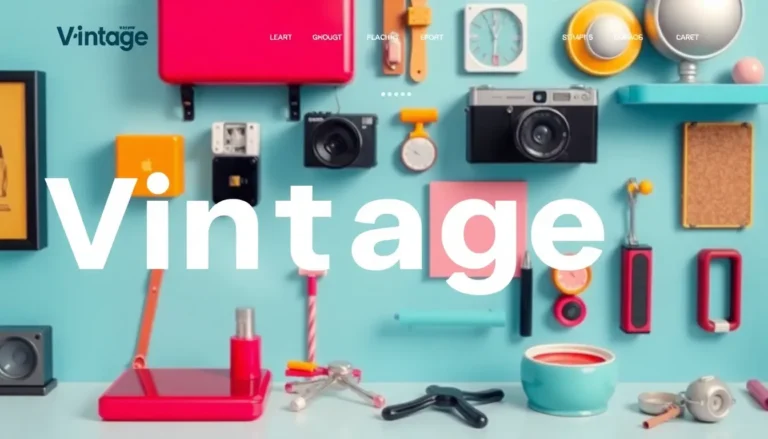In a world where everything seems to come with a price tag, free apps are like hidden treasures waiting to be discovered. They offer a smorgasbord of features without costing a dime, making them the ultimate tech-savvy companion. From productivity boosters to entertainment galore, these apps have something for everyone. Who doesn’t love the thrill of snagging a fantastic deal—even if it’s just a download?
Table of Contents
ToggleOverview of Free Apps
Free apps offer various features without requiring payment. Popular categories include productivity tools, entertainment platforms, and educational resources. Users enjoy access to essential functions, like task management or language learning, at no cost. Many free apps utilize a freemium model, providing basic functions for free while offering premium features for a fee.
They serve as valuable resources for individuals and businesses wanting to maximize their efficiency. Apps like Trello and Slack facilitate organization, enabling users to streamline communication and project management. On the other hand, entertainment apps such as Spotify and YouTube deliver extensive media libraries without charging users upfront.
Security remains a crucial consideration when using free apps. Many reputable free apps prioritize user data protection and incorporate strong encryption methods. Familiarity with ratings and reviews helps users select trusted applications. Common risks include ads and in-app purchases that may arise from using these free tools.
Downloads have skyrocketed, with billions recorded across platforms. The accessibility of free apps contributes to this significant growth in usage. Diverse demographics, including students and professionals, benefit from these tools, simplifying complex tasks and enhancing everyday experiences.
In short, the landscape of free apps continues to evolve. Developers regularly introduce innovative features that cater to user demands. With a wealth of options available, finding the right free app to suit specific needs has never been easier.
Popular Categories of Free Apps

Free apps span numerous categories, offering users valuable options that enhance their daily lives. Here are some of the most popular ones.
Social Media Apps
Social media apps serve as key platforms for communication and content sharing. Users connect with friends and family through apps like Facebook and Instagram. They share photos, updates, and engage with community content. An increasing number of users rely on social media for news and entertainment. As these apps evolve, features like stories and live streaming enrich user experience. An average person spends over two hours daily on these platforms, highlighting their significance in modern life.
Productivity Apps
Productivity apps streamline tasks and improve time management. Applications like Trello and Asana help users organize projects efficiently. These tools often include collaboration features that enhance teamwork. Users gain access to calendar functionalities, note-taking, and to-do lists, all in one place. By maximizing efficiency, productivity apps become integral to both personal and professional environments. Statistics show that individuals using these apps increase their productivity by up to 30%, underscoring their effectiveness.
Entertainment Apps
Entertainment apps provide diverse content options for relaxation and enjoyment. Platforms like Spotify and YouTube boast extensive libraries of music and videos, catering to various tastes. Users can find everything from podcast series to original shows. These apps often use a freemium model, allowing access to basic content for free with advanced options requiring payment. Gaming apps also fall into this category, offering engaging experiences without upfront costs. Over 50% of mobile users engage with entertainment apps, demonstrating their widespread appeal.
Advantages of Using Free Apps
Free apps present numerous benefits that enhance user experience and provide valuable tools.
Cost Savings
Utilizing free apps leads to significant savings. Users spend no money while accessing high-quality features, allowing them to allocate budgets to other priorities. Businesses, especially startups, benefit from this model by minimizing overhead costs. Popular apps like Trello and Slack exemplify this advantage, offering essential services without charging for basic use. The freemium approach allows users to pay only when advanced features become necessary, adding another layer of financial flexibility. Over 80% of users appreciate these cost-effective options, making free apps a favorite choice for many.
Accessibility and Variety
Accessibility is a prominent advantage of free apps. Users from diverse backgrounds can easily download and use these tools, with many available on multiple platforms. The variety of free apps caters to nearly every interest, from productivity to entertainment. Social media platforms like Facebook and Instagram attract millions with user-friendly interfaces. Apps focused on education, such as Duolingo, provide essential learning tools without any financial barriers, helping users acquire new skills. This wide range of options ensures there’s something for everyone, meeting different needs effectively.
Disadvantages of Free Apps
Free apps carry some disadvantages that users should consider. Users often face privacy concerns, as many free apps collect vast amounts of personal data. Some applications share this data with third parties, potentially compromising user security. Trusting the privacy policies and data handling practices of developers is essential, yet users may still feel uncertain about how their information is used.
Limitations of features also present a challenge. Basic functions in many free apps lack the depth found in premium versions. Users often encounter restrictions on usage, such as limited access to tools or functionalities. Many developers adopt a freemium model, encouraging users to buy premium versions for a fuller experience. This model can lead to frustration, as users may find themselves needing to spend money to unlock desired features. Choosing a free app means navigating these trade-offs for potential benefits.
Free apps have transformed the way individuals and businesses approach technology. They provide essential tools for productivity and entertainment without the burden of costs. With a plethora of options available users can find solutions tailored to their unique needs.
While the benefits are substantial the potential drawbacks require careful consideration. Users must remain vigilant about privacy and data security while navigating the freemium landscape. Ultimately the continued growth and innovation in free apps promise exciting opportunities for enhancing everyday experiences. Embracing these tools can lead to improved efficiency and enjoyment in daily life.



